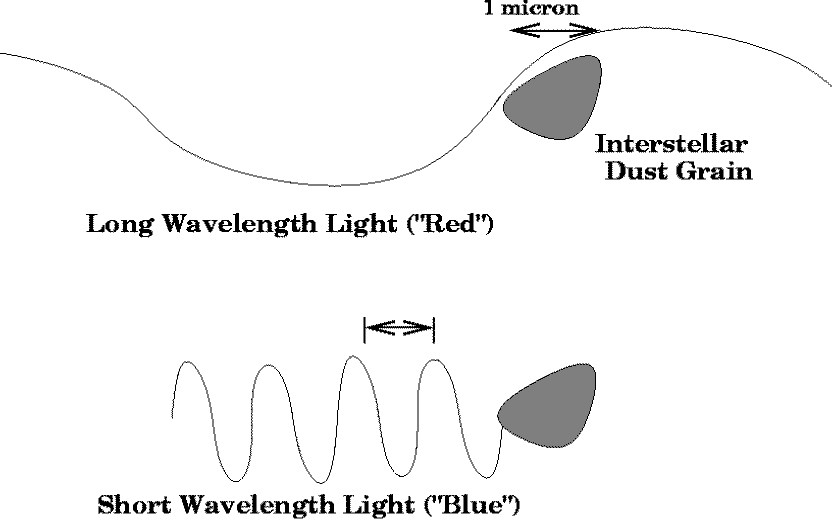We know that blue light suffers extinction more strongly than red (examples include ISM, atmosphere etc.), but why? Is it a property of the shorter wavelength itself? Can someone provide a conceptual explanation as to why this occurs? TIA
-
$\begingroup$ The extinction due to dust is not equally effective at all wavelengths. The shorter the wavelength, the higher the extinction -- blue light is affected more strongly than red light. Therefore, stars behind a lot of dust look redder than they really are. This is called interstellar reddening. $\endgroup$– PranayCommented Jan 27, 2020 at 10:32
-
$\begingroup$ To be exact, it's far more a matter of scattering than actual extinction (i.e. absorption). $\endgroup$– Carl WitthoftCommented Jan 27, 2020 at 20:43
-
$\begingroup$ @CarlWitthoft [Extinction] $\equiv$ [scattering] + [absorption]. Also, scat. and abs. are quite often of the same order of magnitude. $\endgroup$– pelaCommented Jan 27, 2020 at 20:49
-
$\begingroup$ @pela fair enough $\endgroup$– Carl WitthoftCommented Jan 28, 2020 at 12:37
-
$\begingroup$ Beware this is a fact only in atmospheric physics and the other phenomena you have in mind and not a general rule. $\endgroup$– AlchimistaCommented Jan 31, 2020 at 11:09
2 Answers
There are two effects causing this:
The relevant quantity for determining whether or not a photon interacts with a particle is the ratio $$ x \equiv \frac{2\pi r}{\lambda}, $$ where $r$ is a size of the scattering agent.
Rayleigh scattering
When $x\ll 1$, we're in the Rayleigh regime where the wavelength is so long compared to the particle that the electric field of the photon causes charges within the particle to oscillate with the same frequency, effectively resulting in dipole scattering. This has a very strong wavelength dependence, with the probability of interaction begin proportional to $\lambda^{-4}$.
Mie scattering
When $x \sim 1$, we're in the Mie regime, where the probability of interaction is largest. So if you had an ensemble of randomly sized particles with an equal amount of any size, and you shone a beam of light consisting of photons with the same distribution of wavelengths, you would scatter all photons with equal probability (unless of course your distribution extended to very small values of $x$).
However, as with many other things in the Universe — e.g. galaxies, stars, cities, lakes, and wealths — dust grains are not equally distributed in size, but has a distribution which declines as a power law from small to large size. In the case of dust grains, this power is very steep, with a power law slope of roughly $-3.5$; that is, the density $n$ of dust grains as a function of size drops as $$ n(r) \propto r^{-3.5}. $$
Hence, there are many more small dust grains available, casing the blue photons to be scattered much more often.
Larger particles / smaller wavelengths
When $x>1$, but less than $\simeq1.8$, the probability of scattering declines, meaning that in this narrow window, red light is scattered more easily than blue. Coincidentally, these values correspond to optical light and the dust on Mars, leading to blue sunsets, as discussed in this answer.
When $x\gg 1$ — i.e. when the particles become very large compared to the wavelength — we have "geometric scattering", all light is scattered equally. In astronomy, we call this "gray dust", and would be caused e.g. by smalles pebbles.
Scattering vs. absorption
The albedo $A$ of the dust grains — i.e. the probability that an interaction result in a scatter rather than an absorption — is also wavelength dependent, but not as strong. Typical values are of the order of $0.5$, but decreases toward zero for long wavelengths (e.g. Pei 1992)
-
$\begingroup$
+1This is a great answer but I always feel unsatisfied when a "why does this happen?" question is answered with "because of this equation." In Physics there's no end to an explanation, each one can be followed with a subsequent "but why?" but I think something about the polarizability of the dust particles in the incident field and the the dependence of the amplitude of the radiated spherical wave as a function of $x$ would be helpful as well. $\endgroup$– uhohCommented Jan 28, 2020 at 5:54 -
1$\begingroup$ @uhoh I agree, and I initially started writing about where the $\lambda^{-4}$ factor comes from, but it became longer than what I though the OP was interested in. At some point, when I've given it a bit of thought, I'll get back and write as short as possible explanation. $\endgroup$– pelaCommented Jan 28, 2020 at 11:10
Reddening (or the fact that blue light is more extincted than red, causing objects to appear more red) is due to the interaction between the light and the dust grains and gas molecules it is going through, and is caused by the relative size of the dust grains and of the wavelength. Indeed, dust grains are very effective at scattering light which has a wavelength that is about the same size as the grain.
See this illustration from the university of virginia

Dust grains in the interstellar medium are about 1 micron in size or less. Because of this, blue light (0.4 $\mu$m) gets absorbed/scattered by the dust, but red light (0.7 $\mu$m) goes through. Since infrared has an even longer wavelength, there are nebulae that obscure the background stars in visible light, but that are transparent in infrared.
The same phenomenon causes sunsets to appear red, and even more so after a volcanic eruption, when there is more dust in the atmosphere.
-
$\begingroup$ Does the same [as diffraction on particulars] phenomenon cause sunsets to appear red? Did you ever see sunset in clear weather? $\endgroup$ Commented Dec 22, 2020 at 19:47
-
$\begingroup$ Sunset is red due to Rayleigh scattering. Your picture (and explanatory text) are not about Rayleigh scattering. $\endgroup$ Commented Dec 27, 2020 at 18:16